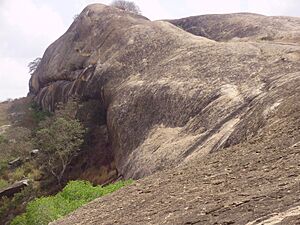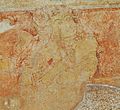Sittanavasal Cave facts for kids
The Sittanavasal Cave is a very old group of caves found in the village of Sittanavasal. This village is in the Pudukottai district of Tamil Nadu, India. The caves were built around the 2nd century AD. The name "Sittanavasal" comes from a Tamil word meaning "the home of great saints."
This special place is a monastery or temple carved right into the rock. It was made by people who followed Jainism, a very old religion. They called it the Arivar Koil, which means a cave temple for the Arihants (respected Jain teachers).
Ancient Art on Walls
The Sittanavasal Cave is famous for its beautiful and very old paintings. These paintings are called frescoes and were made in the 7th century. They are like murals, which are large pictures painted directly onto walls.
The artists used special colors made from plants and minerals. These colors included black, green, yellow, orange, blue, and white. To create the paintings, they put the colors onto a thin, wet layer of lime plaster. This method helped the colors soak into the wall and last a very long time.
Who Built the Cave?
The village of Sittanavasal has been important for a long time, from about 100 BC to 1000 AD. During this period, Jainism was very popular here.
The cave temple itself was first thought to be built by King Mahendravarman I. He was a ruler from the Pallava dynasty who lived from 580 to 630 AD. Before he became a Hindu and a follower of Shaivism, he was a Jain. This connection shows how important Jainism was in this area long ago.
Images for kids








